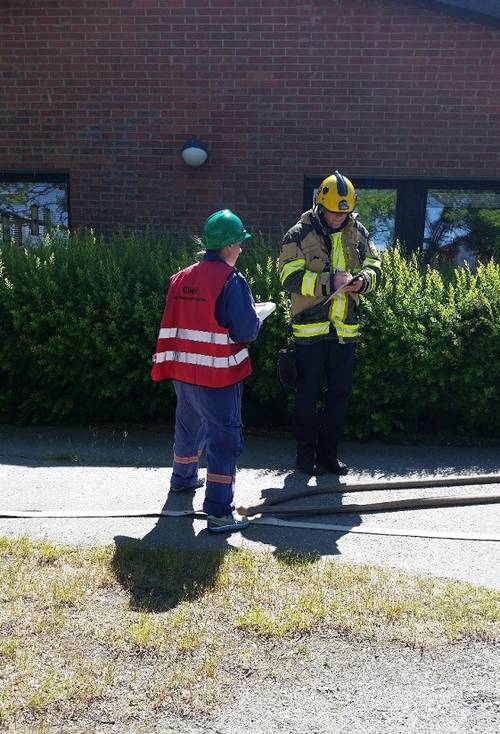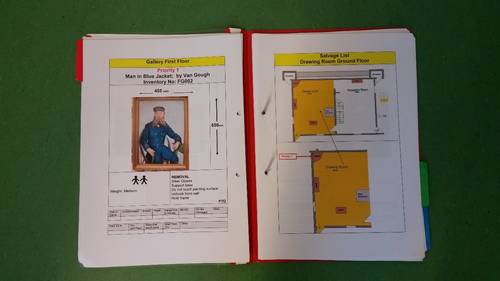Documents before and after a disaster – How to cooperate with others during a fire or other disaster – Erika Hedhammar (October 2018)

Fires and other disasters for museums, archives and libraries happen now and then. Recently, we have heard of the tragic fire at the National museum in Rio de Janeiro, Brazil.
Does your museum, archive or library have a plan for this? What is included in the plan? Does the fire brigade know the museum’s plan?
First of all, we have to prevent that a fire starts at all. In the worst case scenario that we can ´t prevent the fire, we can have a plan and know what to do and how to cooperate to make the impact of the fire as small as possible. The plan is important because the first hours are crucial for what will be left and possible to take care of after a fire.
If the museum staff is not present in the building when a fire starts, the firefighters will probably be the first ones on site. Do they know the building? Do they know it is a museum? Do they know it houses valuable collections and unique objects? Do they know how to get in touch with the museum staff, whether it is in the middle of the night or on Christmas Eve?
The fire brigade should have some documents to help them in their job to fight a fire. They probably need help with some of the information from the museum before something happens. It is a good idea to invite the local fire brigade to the museum. It is helpful for them to know the building.
Some of the information the fire brigade will need before a fire:
- How to get to the museum? Where to enter the museum? Where to park their fire engine?
- Information about the building: doors, stairs, water, electricity, gas, etc.
- Information about fire alarm and sprinklers in the building
- Contact information of the staff and responsible persons

Cooperation with the fire brigade during a training course in Sweden, June 2018 (photo Erika Hedhammar)
The museum also needs to have an emergency plan. The purpose of the emergency plan will be to make it easier for the staff at the museum and the fire brigade to cooperate in case of a fire or other disaster. The museum is responsible for the emergency plan, and it needs to be discussed with the fire brigade.
The emergency plan will have information about:
- Contact information of staff at the museum
- The museum’s organisation during a disaster
- Rescue plan
The rescue plan will contain information about prioritized objects/rooms/parts of the collections. The information has to be discussed with the fire brigade. Can they evacuate a big and heavy stone object? Or can they protect it with something in case of a fire? How would they like the rescue plan? What type of file would make it easy and clear for them to find objects even in a dark and smoky room? Paper sheets or digital files? Where should the files be located? Next to the fire alarm or should digital files be sent to the local fire brigade? Sweden has adopted different solutions in different areas. The solution depends many things, for example if the museum has an automatic fire alarm, and if it is located in a small town or in a big city. And of course, it is important that the information should not be available to thieves.
Many museums I meet have difficulties to make a priority list of things to be saved first. Endless discussions at museums have ended up with no plan at all. I think a plan is very important. How would the fire brigade know about what are museum objects and what are products for the museum gift shop? It is not the fire brigade who should choose, and I think nobody would like to prioritise in the middle of the night or during vacation in case of a fire. Start to choose a few objects or a part of the collection with a large importance for the museum now. It is possible to change later.

Cards for priority 1 object from Historic England’s course “Salvage and Emergency Planning Course” (photo Erika Hedhammar)
The museum also needs to have a plan about how to take care of the collections after a fire or other disaster. There will be a lot of fast decisions to make. Who can decide? For example there might be a need to order freeze containers and equipment to take care of wet objects fast. Who is responsible for the costs/expenses?
Is the museum staff trained in taking care of hundreds of wet and burnt objects? Where to evacuate them? Who can help? Who will lead the work?
The plans also have to be tested and practiced. What worked out well? What did not work out well? Do we have to adjust the plan? There are courses for disaster situation training (see links below). Historic England has organized a course for many years. In Sweden, the Swedish Fire Protection Association and the Swedish National Heritage Board have organized a course similar to the Historic England course. I think both the course teachers and the participants have learned a lot. I hope it gave the participants the motivation to create emergency plans for their museums.
Back to the question I started with: do we have plans for such emergency? What do we need to address such situation? Will a fire at our museum be the eye opener to urge us to prepare ahead of time? Or can we make the plan now and not worry about the day you get a call from the fire brigade reporting a fire at your museum in the middle of the night? Nobody wants to hear about a fire on the local news. Be prepared!
Resources:
- Swedish National Heritage Board https://www.raa.se/in-english/swedish-national-heritage-board/
- Swedish Fire Protection Association https://www.brandskyddsforeningen.se/eng/
Training courses:
- Historic England´s course Salvage and Disaster Recovery https://historicengland.org.uk/services-skills/training-skills/heritage-practice-residential/emergency-planning-salvage/
- ICCROMs course First Aid to Cultural Heritage in Times of Crisis (FAC) https://www.iccrom.org/section/disaster-resilient-heritage/first-aid-cultural-heritage-times-crisis-fac
- The Swedish course https://www.brandskyddsforeningen.se/webbshop/utbildningar/praktisk-restvarderaddning-for-kulturarv/
- The Swedish course in the magazine Brandsäkert https://www.brandsakert.se/2018/0920/praktisk-restv%C3%A4rder%C3%A4ddning-f%C3%B6r-mus%C3%A9er
Emergency planning
- Historic England https://historicengland.org.uk/advice/technical-advice/emergency-and-fire/
- ICCROM Endangered Heritage Emergency Evacuation of Heritage Collections https://www.iccrom.org/sites/default/files/2017-12/endangered-heritage_interactive.pdf
- Swedish National Heritage Board Handbok i katastrofberedskap och restvärdesräddning (RVR) www.raa.se/rvr
- The International Centre for the Study of the Preservation and Restoration of Cultural Property and the Prince Claus Fund have published an innovative handbook and toolkit on First Aid to Cultural Heritage in Times of Crisis – FREE DOWNLOAD – https://www.iccrom.org/news/pioneering-resource-first-aid-cultural-heritage-now-available
Other Resources:
- The Getty Conservation Institute: Etablir un plan d’urgence. Guide pour les musées et autres établissements culturels (Valerie Dorge and Sharon L. Jones) https://www.getty.edu/conservation/publications_resources/pdf_publications/pdf/emergency_fr.pdf
- American Alliance of Museums: Disaster Preparedness and Emergency Response Plan https://www.aam-us.org/programs/ethics-standards-and-professional-practices/disaster-preparedness-and-emergency-response-plan/
Bio:
Erika Hedhammar is risk management adviser at the Swedish National Heritage Board. She has a BSc in conservation from the University of Gothenburg. With her background as textile Conservator, she has dealt with water or fire damaged objects. The ICCROM course First aid to cultural heritage in times of conflict in Rome in 2010 was a definitive eye opener and highlighted the need for organisational solutions. Erika Hedhammar is coordinator for the Swedish network for fire protection and disaster preparedness in cultural environments, administered by the Swedish National Heritage Board. She organises national courses and seminars on disaster preparedness.